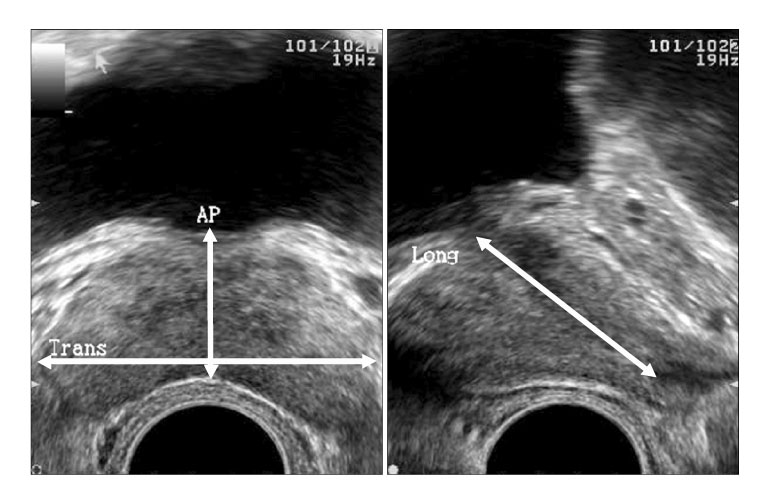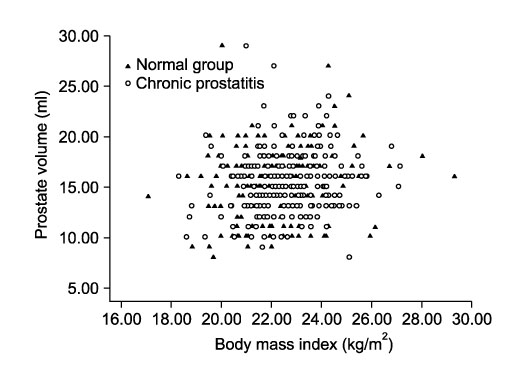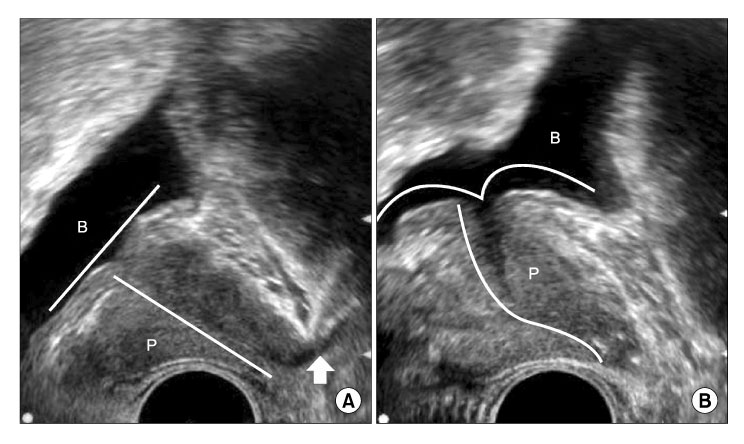Korean J Urol.
2008 Aug;49(8):720-726.
Study of Prostate of Korean Young Adult Using Transrectal Ultrasonography
- Affiliations
-
- 1Department of Urology, National Police Hospital, Seoul, Korea. msk0701@ hanmail.net
- 2Department of Urology, College of Medicine, Gyeongsang National University, Jinju, Korea.
Abstract
-
PURPOSE: The prostate of the young adult is not a subject which has received much attention, and the vast majority of prostate studies have placed their emphasis predominantly on elderly patients. It seems, then, that an investigation of the prostate in younger patients is warranted, and perhaps long past due. Thus, we attempted to determine the mean prostate volume in Koreans in their 20's. We also reported on the relationships between prostate size and body mass index, as well as body surface area, and compared the prostates of normal Korean youths with those of chronic prostatitis patients.
MATERIALS AND METHODS
Between March 2002 and February 2008, we chronicled 583 cases of transrectal ultrasonography(control group: 271, chronic prostatitis group: 314) and calculated prostate volumes via the biplane method. 178 of the cases in the chronic prostatitis group were again examined after treatment. In all of the cases, body mass index and body surface area were assessed.
RESULTS
The mean age of the patient was 22.83+/-2.46 years. The mean prostate volume of the 583 young adults was 15.58+/-3.11ml(control group: 15.61+/-3.16ml, chronic prostatitis group: 15.56+/-3.07ml). We ensured that there were no differences between the normal group and the chronic prostatitis group. The prostate volumes of the chronic prostatitis patients made no odds with the treated prostates. Additionally, prostate volume was directly proportional to the body mass index and the body surface area.
CONCLUSIONS
The prostate volume of young Korean adults in their 20's was approximately 15.6ml. The development of chronic prostatitis in young men had no appreciable effect on prostate size, but was shown to induce a variety of histologic changes in the prostate, and these changes were similar to those observed in older patients.
Keyword
MeSH Terms
Figure
Reference
-
1. Oesterling JE, Kumamoto Y, Tsukamoto T, Girman CJ, Guess HA, Masumori N, et al. Serum prostate-specific antigen in a community-based population of healthy Japanese men: lower values than for similarly aged white men. Br J Urol. 1995. 75:347–353.2. Lee SE, Kim DY, Kwak C. Interrelationship among age, prostate specific antigen and prostate volume in Korean men living at the metropolitan area. Korean J Urol. 1999. 40:1311–1317.3. Kim TW, Lee HL, Kim WJ. Prostatic size variation with age: randomized community-based survey in Chungbuk province. Korean J Urol. 1998. 39:762–765.4. Griffiths CJ, Crooks AJ, Roberts EE, Evans KT, Buck AC, Thomas PJ, et al. Ultrasonic appearances associated with prostatic inflammation: a preliminary study. Clin Radiol. 1984. 35:342–345.5. Doble A, Carter SS. Ultrasonographic findings in prostatitis. Urol Clin North Am. 1989. 16:763–772.6. DuBois D, DuBois EF. A formula to estimate the approximate surface area if height and weight be known. Arch Intern Med. 1916. 17:863–871.7. Wang Y, Moss J, Thisted R. Predictors of body surface area. J Clin Anesth. 1992. 4:4–10.8. Littrup PJ, Kane RA, Williams CR, Egglin TK, Lee F, Torp-Pedersen S, et al. Determination of prostate volume with transrectal US for cancer screening. Part I. Comparison with prostate-specific antigen assays. Radiology. 1991. 178:537–542.9. Cooner WH, Mosley BR, Rutherford CL Jr, Beard JH, Pond HS, Bass RB Jr, et al. Clinical application of transrectal ultrasonography and prostate-specific antigen in the search for prostate cancer. J Urol. 1988. 139:758–761.10. Isaacs JT, Coffey DS. Etiology and disease process of benign prostatic hyperplasia. Prostate. 1989. 2:Suppl. 33–50.11. Berry SJ, Coffey DS, Walsh PC, Ewing LL. The development of human benign prostate hyperplasia with age. J Urol. 1984. 132:474–479.12. al-Rimawi M, Griffiths DJ, Boake RC, Mador DR, Johnson MA. Transrectal ultrasound versus magnetic resonance imaging in the estimation of prostatic volume. Br J Urol. 1994. 74:596–600.13. Tewari A, Indudhara R, Shinohara K, Schalow E, Woods M, Lee R, et al. Comparison of transrectal ultrasound prostatic volume estimation and surgical specimen weight in patients with benign prostatic hyperplasia. J Clin Ultrasound. 1996. 24:169–174.14. Sosna J, Rofsky NM, Gaston SM, DeWolf WC, Lenkinski RE. Determinations of prostate volume at 3-Tesla using an external phased array coil: comparison to pathologic specimens. Acad Radiol. 2003. 10:846–853.15. Glynn RJ, Campion EW, Bouchard GR, Silbert JE. The development of benign prostatic hyperplasia among volunteers in the normative aging study. Am J Epidemiol. 1985. 121:78–90.16. Lee CK, Rhew HY, An HJ. Errors of prostate volume between actual models and transrectal ultrasonographic measurement. Korean J Urol. 1999. 40:1640–1646.17. Allison DB, Fontaine KR, Manson JE, Stevens J, VanItalie TB. Annual deaths attributable to obesity in the United States. JAMA. 1999. 282:1530–1538.18. Amling CL, Kane CJ, Riffenburgh RH, Ward JF, Roberts JL, Lance RS, et al. Relationship between obesity and race in predicting adverse pathologic variables in patients undergoing radical prostatectomy. Urology. 2001. 58:723–728.19. Roberts RO, Jacobson DJ, Girman CJ, Rhodes T, Klee GG, Lieber MM, et al. Insulin-like growth factor I, insulin-like growth factor binding protein 3, and urologic measures of benign prostatic hyperplasia. Am J Epidemiol. 2003. 157:784–791.20. Partin AW, Oesterling JE, Epstein JI, Horton R, Walsh PC. Influence of age and endocrine factors on the volume of benign prostatic hyperplasia. J Urol. 1991. 145:405–409.21. Freedland SJ, Platz EA, Presti JC Jr, Aronson WJ, Amling CL, Kane CJ, et al. Obesity, serum prostate specific antigen and prostate size: implications for prostate cancer detection. J Urol. 2006. 175:500–504.22. Choi YI, Choi HS. The findings of transrectal ultrasonography in evaluation of chronic prostatitis. Korean J Urol. 1994. 35:1218–1223.23. Park SC, Cho IR, Park SS. What are the characteristic transrectal ultrasonographic findings in chronic prostatitis? Korean J Urol. 1998. 39:530–536.
- Full Text Links
- Actions
-
Cited
- CITED
-
- Close
- Share
- Similar articles
-
- Diagnostic Value of Transrectal Ultrasonography for Prostatic Cancer
- Transrectal Ultrasonography of the Prostate and Seminal Vesicles with Hemospermia
- The Transrectal Ultrasonographic Examination of the Prostate Tumor
- Pain during Transrectal Ultrasound-Guided Prostate Biopsy and the Role of Periprostatic Nerve Block: What Radiologists Should Know
- Correlations between the Various Methods of Estimating Prostate Volume: Transabdominal, Transrectal, and Three-Dimensional US





